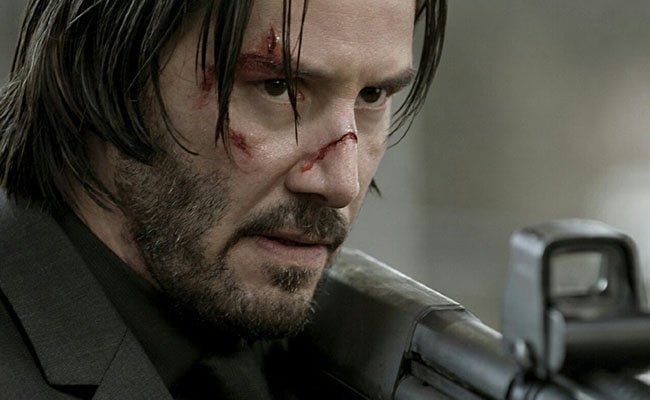
If John Wick asks to borrow your pencil, it’s probably wise to vacate the premises immediately. Yes, the one man slaughterhouse and his turtleneck are back! Less a sequel than a direct continuation, John Wick: Chapter 2 picks up where its 2014 predecessor left off. This master class in operatic violence may not be as emotionally involving as John Wick, but it gives you everything you expect in thrillingly unexpected ways. From New York to Rome and back again, this blood-soaked plunge into the surprisingly mannered world of assassins delivers every kill with ruthless precision.
“Every marker must be honored.”
The assassin John Wick (Keanu Reeves) might have avenged the death of his pooch and the memory of his wife, but he also released a few demons when he abandoned retirement. One such demon, Santino D’Antonio (Riccardo Scamarcio), holds a blood marker on Wick; a solemn debt that must be repaid or risk violating the assassin’s code of ethics. That quaint notion of ethics is what sets this franchise apart from its more systematic counterparts in Bond and Bourne.
In fact, it’s this blend of old fashioned values and New World nihilism that makes John Wick: Chapter 2 such an irresistible adrenaline fix. Like some Arthurian fairytale, Wick is charged with assassinating D’Antonio’s sister, Gianna (Claudia Gerini), so that he may usurp her seat at the High Table. Just who the 12 people are at this High Table and what role they play in the criminal underworld is left tantalizingly unanswered. The notion of alliances and boundaries and kingly criminals clashes beautifully with the solitary existence of the assassin. Like dedicated samurai or mafia foot soldiers, they honor their masters and the antiquated code of laws that bind them together.
If John Wick severed Wick’s last emotional ties to the civilized world, John Wick: Chapter 2 tests his allegiance to the assassin’s code.
“Rules… without them we live with the animals,” advises Winston (Ian McShane), the kindly but deadly keeper of the last refuge of a scoundrel, the Continental. The strange and precise etiquette at the Continental was one of the sublime pleasures of John Wick. In John Wick: Chapter 2 the mythology deepens, as we learn that the governing auspices of the Continental extend across the globe. Wick takes refuge with Winston’s Italian counterpart, Julius (a brilliant cameo by Franco Nero). There, he’s outfitted by an attentive tailor for maximum stylishness (and bullet resistance), while the Sommelier (Peter Serafinowicz) treats him to an entrée of hi-tech weaponry in the film’s cheekiest scene.
Choosing the best scene in John Wick: Chapter 2 is a difficult task, as returning director Chad Stahelski packs this unrelenting ride with plenty of worthy contenders. Wick’s operatic and bloody confrontation with Gianna, for example, is unexpectedly poignant and haunting, as the two wounded samurais lament the indiscretions of their masters. There’s also a disorienting callback to the Room of Mirrors finalé from Enter the Dragon, which modernizes the locale to a trendy New York art museum.
Let us not forget the most casual gunfight in cinematic history, as Wick and Gianna’s protector, Cassian (Common), exchange bullets during a nonchalant stroll through a crowded subway station. And that’s not even mentioning the reunion between Reeves and his Matrix mentor, Laurence Fishburne, who plays a half-crazed poet-assassin named the Bowery King. When it comes to memorable scenes, John Wick: Chapter 2 is an embarrassment of knuckle busting riches.
When it comes to the knuckle busting, Stahelski choreographs each fight sequence for maximum impact, making great use of both confined and open spaces. Whether it’s a cramped subway car or the misty corridors of some ancient Roman catacombs, cinematographer Dan Laustsen gives each fight scene a distinctive look and personality. Stahelski takes familiar action tropes and re-imagines them with unparalleled immediacy and brutality. Yes, the digitally-enhanced arterial sprays and head shots are excessive, but that never detracts from the impressive stunts or practical effects.
It’s precisely this excessiveness that makes John Wick: Chapter 2 so much fun. Writer Derek Kolstad knows he can’t recapture the fragile humanity of John Wick, so he mines the absurdity for humor, instead. Wick is a seemingly indestructible ‘boogeyman’ driven by vengeance; striking terror into the most hardened of criminals. This exaggerated dread makes even a throwaway scene like Peter Stormare’s petrified Mafioso boss listening to the distant screams of his henchman play like a masterpiece in understated physical comedy. With every kill, the legend of Wick grows, and the filmmakers are eager to embellish all of the hilariously dark details.
John Wick: Chapter 2 is better than most sequels because it isn’t content to simply copy the elements that made its predecessor great. The filmmakers have created a hermetically sealed world of musty ethics and red leather boxes filled with gold coins. Telephone operators frantically route calls through old-time switchboards and carrier pigeons flutter in the shadow of the Brooklyn Bridge. This traditionalism anchors the swirling modernism of breaking bones and splattered brains, expanding the story beyond mere spectacle, into something we can care about.
John Wick: Chapter 2 functions nicely as a standalone film but also sets the stage for one humdinger of a finalé. Whether or not John Wick can escape his basic nature remains unclear, but his moral dilemma makes for a bloody good time.

